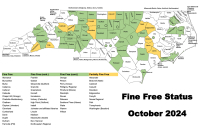A skunk by any other name
Five skunk species are residents in the United States: hooded, hog-nosed, western spotted, eastern spotted, and striped. Only the last two reside in the Smokies region.
The striped skunk — which is black with two white stripes running up its back to form a cap on top of its head — is the one that usually comes to mind when someone starts telling skunk tales in this neck of the woods.
The spotted skunk is, in my experience, more common in the higher elevations. Sometimes referred to as a civet, it is black with a white spot on its forehead and under each ear. There are also four broken white stripes along its neck, back, and sides, as well as a white-tipped tail.
Now we get to the interesting part. When provoked, a striped skunk simply raises its tail daintily like a plume and assumes a U-shaped posture that allows its hip muscles to squeeze the odiferous fluids indiscriminately out of its anal glands.
The spotted skunk has perfected that basic strategy. When frightened or angered, it will often do a “handstand” on it front feet. This posture allows the critter to look between its legs and see where to aim the spray.
Many readers of this column will have encountered skunks in the shelters along the Appalachian Trail, especially those situated in the Great Smoky Mountains National Park. Long before the park was established in 1934, writer and outdoorsman Horace Kephart underwent a typical skunk “invasion.” It took place in the Hall Cabin, a hut situated smack-dab on the state line between Tennessee and North Carolina. Kephart subsequently described the incident in his book Camping and Woodcraft — first published in a single volume in 1906 but later expanded to two volumes in 1916.
Related Items
He somehow identified his visitor as a female but failed to note whether it was spotted or striped. I suspect it was the latter. Be forewarned that this skunk story has a sad ending.
“Another notoriously fearless pest is the skunk. It will turn tail quickly enough, but nothing on earth will make it run. If a skunk takes it into his head to raid your camp he will step right in without any precautions whatever. Then he will nose through all of your possessions, walk over you — if you be in his way — and forty men cannot intimidate him.
Once, when I was spending the summer in a herders’ hut, on a summit of the Smoky Mountains, a skunk burrowed under the cabin wall and came up through the earthen floor. It was about midnight. My two companions slept in a pole bunk against the wall, and I had an army cot in the middle of the room. It was cold enough for an all-night fire on the hearth.
I awoke with the uneasy feeling that some intruder was moving about in the darkness. There was no noise, and my first thought was of rattlesnakes, which were numerous in that region. I sat up and lit the lantern, which hung over my head. One glance was enough.
“Boys,” I warned in a stage whisper, “for the love of God, don’t breathe; there’s a skunk at the foot of my bed!”
The animal was not in the least disconcerted by the light, but proceeded leisurely to inspect the premises. It went under my cot and nosed around there for five mortal minutes, while I lay rigid as a corpse.
Then Doc sneezed. I heard Andy groan from under his blanket: “You damn fool: now we’ll get it!”
But we didn’t. Madame Polecat waddled to their bunk, and I had a vision of two fellows sweating blood.
Then she moved over to the grub chest, found some excelsior lying beside it, and deliberately went to work on making a nest. An hour passed. I simply had to take a smoke. My tobacco was on a shelf right over the skunk. I risked all, arose very quietly, reached over the beast, got my tobacco, and retired like a ghost to the other end of the cabin to warm myself at the fire.
We were prisoners; for the only door was a clapboard affair on wooden hinges that shrieked like a dry axle. The visitor, having made its bed, did not yet feel like turning in, but decided to find out what sort of a bare-legged, white-faced critter I was, anyhow.
It came straight over to the fireplace and sniffed my toes. The other boys offered all sorts of advice, and I talked brimstone back at them — we had found that pussy didn’t care a hang for human speech so long as it was gently modulated.
That was a most amiable female of her species. True, she investigated all our property that was within reach, but she respected it, and finally she cuddled up in the excelsior, quite satisfied with her new home.
To cut an awfully long story short, the polecat held us spellbound until daybreak. Then she crawled out through her burrow, and we instantly fled through our shrieky door. Doc had a shotgun in his hand and murder in his heart. Not being well posted on skunk reflexes, he stepped up within ten feet and blew the animal’s head clean off by a simultaneous discharge of both barrels.
Did that headless skunk retaliate? It did, brethren, it did!”
George Ellison wrote the biographical introductions for the reissues of two Appalachian classics: Horace Kephart’s Our Southern Highlanders and James Mooney’s History, Myths, and Sacred Formulas of the Cherokees. In June 2005, a selection of his Back Then columns was published by The History Press in Charleston as Mountain Passages: Natural and Cultural History of Western North Carolina and the Great Smoky Mountains. Readers can contact him at P.O. Box 1262, Bryson City, N.C., 28713, or at This email address is being protected from spambots. You need JavaScript enabled to view it..









